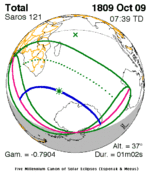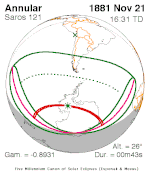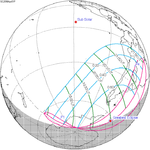Solar eclipse of February 28, 2044
| Solar eclipse of February 28, 2044 | |
|---|---|
| Type of eclipse | |
| Nature | Annular |
| Gamma | −0.9954 |
| Magnitude | 0.96 |
| Maximum eclipse | |
| Duration | 147 s (2 min 27 s) |
| Coordinates | 62°12′S 25°36′W / 62.2°S 25.6°W |
| Max. width of band | - km |
| Times (UTC) | |
| Greatest eclipse | 20:24:40 |
| References | |
| Saros | 121 (62 of 71) |
| Catalog # (SE5000) | 9605 |
An annular solar eclipse will occur at the Moon's ascending node of orbit on Sunday, February 28, 2044, with a magnitude of 0.96. A solar eclipse occurs when the Moon passes between Earth and the Sun, thereby totally or partly obscuring the image of the Sun for a viewer on Earth. An annular solar eclipse occurs when the Moon's apparent diameter is smaller than the Sun's, blocking most of the Sun's light and causing the Sun to look like an annulus (ring). An annular eclipse appears as a partial eclipse over a region of the Earth thousands of kilometres wide.
This is the last of 55 umbral eclipses of Solar Saros 121. The 1st was in 1070 and the 55th will be in 2044. The total duration is 974 years.
Images
Related eclipses
Eclipses in 2044
- An annular solar eclipse on February 28, 2044.
- A total lunar eclipse on March 13, 2044.
- A total solar eclipse on August 23, 2044.
- A total lunar eclipse on September 7, 2044.
Metonic
- Preceded by: Solar eclipse of May 11, 2040
- Followed by: Solar eclipse of December 16, 2047
Tzolkinex
- Preceded by: Solar eclipse of January 16, 2037
- Followed by: Solar eclipse of April 11, 2051
Half-Saros
- Preceded by: Lunar eclipse of February 22, 2035
- Followed by: Lunar eclipse of March 4, 2053
Tritos
- Preceded by: Solar eclipse of March 30, 2033
- Followed by: Solar eclipse of January 27, 2055
Solar Saros 121
- Preceded by: Solar eclipse of February 17, 2026
- Followed by: Solar eclipse of March 11, 2062
Inex
- Preceded by: Solar eclipse of March 20, 2015
- Followed by: Solar eclipse of February 7, 2073
Triad
- Preceded by: Solar eclipse of April 30, 1957
- Followed by: Solar eclipse of December 30, 2130
Solar eclipses of 2044–2047
This eclipse is a member of a semester series. An eclipse in a semester series of solar eclipses repeats approximately every 177 days and 4 hours (a semester) at alternating nodes of the Moon's orbit.[1]
| Solar eclipse series sets from 2044 to 2047 | ||||||
|---|---|---|---|---|---|---|
| Ascending node | Descending node | |||||
| 121 | February 28, 2044 Annular |
126 | August 23, 2044 Total | |||
| 131 | February 16, 2045 Annular |
136 | August 12, 2045 Total | |||
| 141 | February 5, 2046 Annular |
146 | August 2, 2046 Total | |||
| 151 | January 26, 2047 Partial |
156 | July 22, 2047 Partial | |||
| Partial solar eclipses on June 23, 2047 and December 16, 2047 occur on the next lunar year eclipse set. | ||||||
Saros 121
Solar saros 121, repeating every about 18 years, 11 days, and 8 hours, contains 71 events. The series started with a partial solar eclipse on April 25, 944. It contains total eclipses from July 10, 1070, to October 9, 1809. It contains hybrid eclipses on October 20, 1827, and October 30, 1845. It contains annular eclipses from November 11, 1863, to February 28, 2044. The series ends at member 71 as a partial eclipse on June 7, 2206. The longest total eclipse occurred on June 21, 1629, with greatest duration of totality at 6 minutes and 20 seconds. The longest annular eclipse will occur on February 28, 2044, with greatest duration of annularity at 2 minutes and 27 seconds.[2]
| Series members 49–65 occur between 1801 and 2100: | ||
|---|---|---|
| 49 | 50 | 51 |
 October 9, 1809 |
 October 20, 1827 |
 October 30, 1845 |
| 52 | 53 | 54 |
 November 11, 1863 |
 November 21, 1881 |
 December 3, 1899 |
| 55 | 56 | 57 |
 December 14, 1917 |
 December 25, 1935 |
 January 5, 1954 |
| 58 | 59 | 60 |
 January 16, 1972 |
 January 26, 1990 |
 February 7, 2008 |
| 61 | 62 | 63 |
 February 17, 2026 |
 February 28, 2044 |
 March 11, 2062 |
| 64 | 65 | |
 March 21, 2080 |
 April 1, 2098 | |
References
- ^ van Gent, R.H. "Solar- and Lunar-Eclipse Predictions from Antiquity to the Present". A Catalogue of Eclipse Cycles. Utrecht University. Retrieved 6 October 2018.
- ^ Saros Series Catalog of Solar Eclipses NASA Eclipse Web Site.


